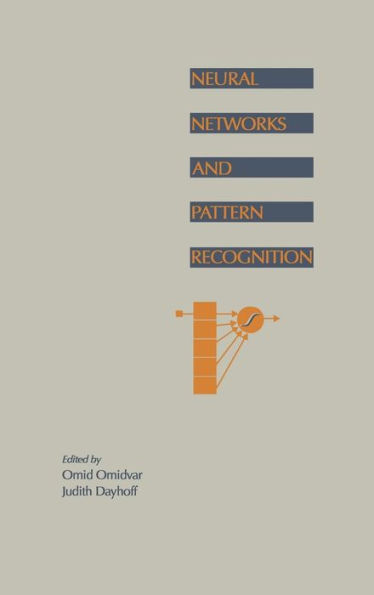5
1
9780125264204



Neural Networks and Pattern Recognition available in Hardcover, eBook

Neural Networks and Pattern Recognition
by Omid Omidvar, Judith Dayhoff
Omid Omidvar
- ISBN-10:
- 0125264208
- ISBN-13:
- 9780125264204
- Pub. Date:
- 10/20/1997
- Publisher:
- Elsevier Science
- ISBN-10:
- 0125264208
- ISBN-13:
- 9780125264204
- Pub. Date:
- 10/20/1997
- Publisher:
- Elsevier Science

Neural Networks and Pattern Recognition
by Omid Omidvar, Judith Dayhoff
Omid Omidvar
$106.0
Buy New
$106.00
$106.00
106.0
In Stock
Overview
This book is one of the most up-to-date and cutting-edge texts available on the rapidly growing application area of neural networks. Neural Networks and Pattern Recognition focuses on the use of neural networksin pattern recognition, a very important application area for neural networks technology. The contributors are widely known and highly respected researchers and practitioners in the field.

Product Details
| ISBN-13: | 9780125264204 |
|---|---|
| Publisher: | Elsevier Science |
| Publication date: | 10/20/1997 |
| Pages: | 351 |
| Product dimensions: | 6.00(w) x 9.00(h) x (d) |
About the Author
Omid Omidvar is a professor of Computer Science at the University of Computer Science at the University of the District of Columbia, Washington, D.C. He is also a technical director of SPPARC center; a supercomputing facility funded by NSF. He received his Ph.D. from the University of Oklahoma in 1967 and has done extensive work in applications of Neural Networks in Optical Character Recognition and Finger Print for the National Institute of Standards and Technology. Dr. Omidvar has been a consultant to many of the world's most important corporations including IBM, Sun, Gumann, and has completed a five year project for the District of Columbia NASA Consortium in design and performance evaluation of neurocontrollers. Dr. Omidvar is also the Editor-in-Chief of the Journal of Artificial Neural Networks, has been an editor of Progress in Neural Network Series since 1990, and has published a large number of journal and conference publications. In addition to teaching, Dr. Omidvar is also currently working as a computer scientist in the Image Recognition Group, Advanced System Division, at NIST.
Table of Contents
Preface. Contributors. J.L. Johnson, H. Ranganath, G. Kuntimad, and H.J. Caulfield,Pulse-Coupled Neural Networks.H. Li and J. Wang,A Neural Network Model for Optical Flow Computation.F. Unal and N. Tepedelenlioglu,Temporal Pattern Matching Using an Artificial Neural Network.J. Dayhoff, P. Palmadesso, F. Richards, and D.-T. Lin, Patterns of Dynamic Activity and Timing in Neural Network Processing. J. Ghosh, H.-J. Chang, and K. Liano, A Macroscopic Model of Oscillation in Ensembles of Inhibitory and Excitatory Neurons. P. Tito, B. Horne, C.L. Giles, and P. Collingwood, Finite State Machines and Recurrent Neural Networks—Automata and Dynamical Systems Approaches. R. Anderson, Biased Random-Walk Learning: A Neurobiological Correlate to Trial-and-Error. A. Nigrin, Using SONNET 1 to Segment Continuous Sequences of Items. K. Venkatesh, A. Pandya, and S. Hsu,On the Use of High Level Petri Nets in the Modeling of Biological Neural Networks. J. Principe, S. Celebi, B. de Vries, and J. Harris, Locally Recurrent Networks: The Gamma Operator, Properties, and Extensions.Preface. Contributors. J.L. Johnson, H. Ranganath, G. Kuntimad, and H.J. Caulfield, Pulse-Coupled Neural Networks: Introduction. Basic Model. Multiple Pulses. Multiple Receptive Field Inputs. Time Evolution of Two Cells. Space to Time. LinkingWaves and Time Scales. Groups. Invariances. Segmentation. Adaptation. Time to Space. Implementations. Integration into Systems. Concluding Remarks. References. H. Li and J. Wang, A Neural Network Model for Optical Flow Computation: Introduction. Theoretical Background. Discussion on the Reformulation. Choosing Regularization Parameters. A Recurrent Neural Network Model. Experiments. Comparison to Other Work. Summary and Discussion. References. F. Unal and N. Tepedelenlioglu, TemporalPattern Matching Using an Artificial Neural Network: Introduction. Solving Optimization Problems Using the Hopfield Network. Dynamic Time Warping Using Hopfield Network. Computer Simulation Results. Conclusions. References. J. Dayhoff, P. Palmadesso, F. Richards, and D.-T. Lin, Patterns of Dynamic Activity and Timing in Neural Network Processing: Introduction. Dynamic Networks. Chaotic Attractors and Attractor Locking. Developing Multiple Attractors. Attractor Basins and Dynamic Binary Networks. Time Delay Mechanisms and Attractor Training. Timing of Action Potentials in Impulse Trains. Discussion. Acknowledgments. References. J. Ghosh, H.-J. Chang, and K. Liano, A Macroscopic Model of Oscillation in Ensembles of Inhibitory and Excitatory Neurons: Introduction. A Macroscopic Model for Cell Assemblies. Interactions Between Two Neural Groups. Stability of Equilibrium States. Oscillation Frequency Estimation. Experimental Validation. Conclusion. Appendix. References. P. Tito, B. Horne, C.L. Giles, and P. Collingwood, Finite State Machines and Recurrent Neural Networks—Automata and Dynamical Systems Approaches: Introduction. State Machines. Dynamical Systems. Recurrent Neural Network. RNN as a State Machine. RNN as a Collection of Dynamical Systems. RNN with Two State Neurons. Experiments—Learning Loops of FSM. Discussion. References. R. Anderson, Biased Random-Walk Learning: A Neurobiological Correlate to Trial-and-Error: Introduction. Hebb's Rule. Theoretical Learning Rules. Biological Evidence. Conclusions. Acknowledgments. References and Bibliography. A. Nigrin, Using SONNET 1 to Segment Continuous Sequences of Items: Introduction. Learning Isolated and Embedded Spatial Patterns. Storing Items with Decreasing Activity. The LTM Invariance Principle. Using Rehearsal to Process Arbitrarily Long Lists. Implementing the LTM Invariance Principle with an On-Center Off-Surround Circuit. Resetting Items Once They can be Classified. Properties of a Classifying System. Simulations. Discussion. K. Venkatesh, A. Pandya, and S. Hsu, On the Use of High Level Petri Nets in the Modeling of Biological Neural Networks: Introduction. Fundamentals of PNs. Modeling of Biological Neural Systems with High Level PNs. New/Modified Elements Added to HPNs to Model BNNs. Example of a BNN: The Olfactory Bulb. Conclusions. References. J. Principe, S. Celebi, B. de Vries, and J. Harris, Locally Recurrent Networks: The Gamma Operator, Properties, and Extensions: Introduction. Linear Finite Dimensional Memory Structures. The Gamma Neural Network. Applications of the Gamma Memory. Interpretations of the Gamma Memory. Laguerre and Gamma II Memories. Analog VLSI Implementations of the Gamma Filter. Conclusions. References.From the B&N Reads Blog
Page 1 of
